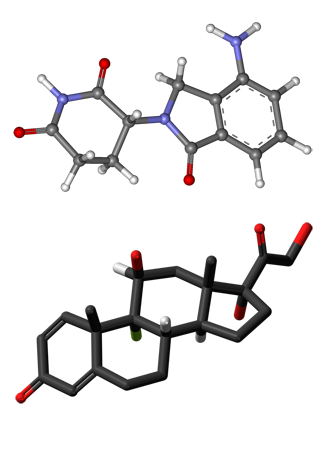Front-Line Combo for Multiple Myeloma Shows Survival Benefit
The combination of lenalidomide plus dexamethasone demonstrated an improvement in both response rate and survival in newly diagnosed multiple myeloma patients not eligible for a stem cell transplant, according to data presented at the 2013 ASH meeting.
Ball-and-stick models of lenalidomide (top) and dexamethasone (bottom)

The combination of lenalidomide plus dexamethasone demonstrated an improvement in both response rate and survival over the current standard of care in newly diagnosed multiple myeloma patients not eligible for a stem cell transplant-the combination of melphalan, prednisone, and thalidomide (MPT).
The progression-free survival (PFS) was 25.5 months in the lenalidomide plus dexamethasone arm compared with 21.2 months in the MPT treatment arm (hazard ratio [HR] = 0.72; P = .00006).
The initial results from the international phase III FIRST (Frontline Investigation of Lenalidomide Plus Dexamethasone vs Standard Thalidomide) trial were presented at the plenary session of the 2013 American Society of Hematology (ASH) Annual Meeting and Exposition held in New Orleans.
“The FIRST trial establishes continuous lenalidomide plus low-dose dexamethasone as a new standard of care,” said presenter Thierry Facon, MD, of the Hôpital Claude Huriez, CHRU Lille, France.
“The results of the trial are significant for patients treated in North America,” said Joseph R. Mikhael, MD, of the Mayo Clinic in Arizona, moderator at a press conference, where the data was presented.
The FIRST trial randomized 1,623 patients with newly diagnosed multiple myeloma equally to one of three treatment arms: lenalidomide plus low-dose dexamethasone given continuously; the same combination given for 18 cycles over 18 months; or to the current standard of care, MPT. Patients were either at least 65 years old or were not candidates for a stem cell transplant. Patients were followed up for 37 months. The international trial enrolled patients from 18 countries in North America, Europe, Asia, and Australia and New Zealand. The median age of patients in the trial was 73. The study is the largest randomized study in newly diagnosed multiple myeloma patients, according to Facon.
The traditional fixed duration MPT regimen has a median PFS of about 20.3 months based on prior data.
The difference in PFS between the continuous dosing lenalidomide treatment arm compared with the fixed duration lenalidomide arm was significant: The median PFS of the fixed duration lenalidomide treatment arm was 20.7 months (HR = 0.7; P = .00001).
At 3 years, the PFS rate was 42% in the continuous dosing lenalidomide arm compared with 23% in both the fixed duration lenalidomide and MPT treatment arms.
The 4-year overall survival rate was 59.4% in the continuous dosing lenalidomide arm compared with 51.4% in the MPT arm (HR = 0.78; P = .0168). The 4-year overall survival rate was 55.7% in the fixed duration lenalidomide arm. The difference between the overall survival of the two lenalidomide treatment arms was not statistically significant.
The rate of discontinuation due to adverse events was similar for all three treatment arms-11%, 13%, and 14% for the continuous dosing lenalidomide, fixed duration lenalidomide, and MPT regimens, respectively. Grade 3/4 neutropenia, thrombocytopenia, febrile neutropenia, and neuropathy were lower in the continuous dosing lenalidomide arm compared with the MPT arm (28% vs 45%, 8% vs 11%, 1% vs 3%, and 5% vs 15%, respectively). Infections and deep-vein thrombosis were slightly higher in the continuous dosing lenalidomide arm.
Second primary malignancies (SPM) were lower in the continuous dosing lenalidomide arm. A total of 12 patients had hematologic SPM in the MPT arm compared with 2 patients in each of the lenalidomide arms. The low incidence was not surprising, said Facon.
Lenalidomide is marketed as Revlimid by New Jersey-based Celgene and is approved by the US Food and Drug Administration for use in multiple myeloma patients after one prior therapy.
Newsletter
Stay up to date on recent advances in the multidisciplinary approach to cancer.